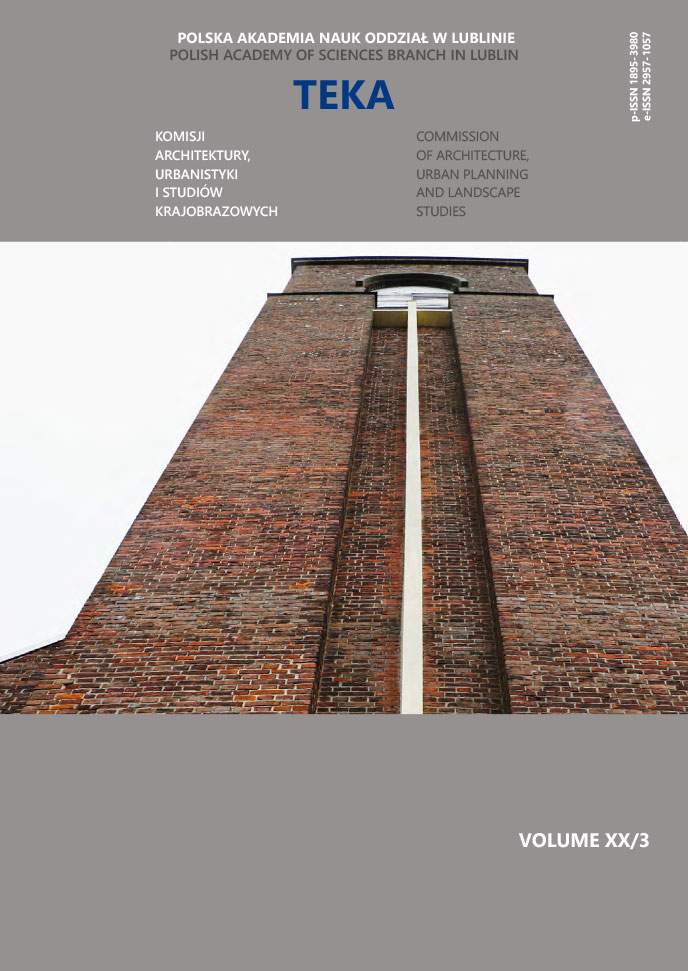Ocena jakości wykonania dotychczasowych termomodernizacji i próba klasyfikacji charakterystycznych problemów za pomocą dwupoziomowej termografii
Anna Ostańska
a.ostanska@pollub.plKatedra Architektury, Urbanistyki i Planowania Przestrzennego, Wydział Budownictwa i Architektury, Politechnika Lubelska (Polska)
https://orcid.org/0000-0002-1789-4288
Abstrakt
W badaniach zastosowano termografię dwuetapową. Oznacza to, że termogramy w pierwszym etapie badań termograficznych wykonano z wykorzystaniem transportu lotniczego (oblot osiedla helikopterem). Następnie, po wytypowaniu nieszczelnych termicznie budynków, w drugim etapie badań termograficznych dokonano obserwacji z poziomu terenu (obchód i oględziny elementów budynków wytypowanych w pierwszym etapie).
Celem badań w podczerwieni, sukcesywnie prowadzonych od 2006 do 2020 roku, była bieżąca ocena jakości izolacji termicznej budynków wielorodzinnych metodą nieniszczącą oraz próba określenia niezbędnych zaleceń naprawczych, których celem jest wyeliminowanie pozostałych lub nowo powstałych nieszczelności termicznych w powłoce budynku oraz zrównoważona eksploatacja budynku wielorodzinnego.
W artykule przedstawiono wyniki badań termograficznych oraz zaproponowano trzy sposoby analizy (wstępną, jakości i statystyczną).
Słowa kluczowe:
zrównoważona eksploatacja budynków wielorodzinnych, termomodernizacja, oszczędzanie energii, opinia użytkownikówBibliografia
Ostańska A.E., Propozycja metody oceny diagnostycznej w podczerwieni termomodernizowanych budynków wielorodzinnych, Builder, 2021, Open Access Journals, XXV.290/9/2021, s. 35−37. DOI:10.5604/01.3001.0015.1939.
DOI: https://doi.org/10.5604/01.3001.0015.1939
Google Scholar
Zyga J., Ocena budownictwa wielkopłytowego przez pryzmat rynku nieruchomości, Budownictwo i Architektura, 2014, vol. 13, nr 3, s. 57−64.
Google Scholar
Nowogońska B., Magdalena Mielczarek, Renovation management method in neglected buildings, Sustainability (Switzerland), 2021, 13 (2), 929. DOI: 10.3390/su13020929.
DOI: https://doi.org/10.3390/su13020929
Google Scholar
Nowogońska B., A methodology for determining the rehabilitation needs of buildings, Applied Sciences (Switzerland), 2020, 10 (11), 3873, DOI:10.3390/app10113873.
DOI: https://doi.org/10.3390/app10113873
Google Scholar
Ostańska A., Programowanie rewitalizacji osiedli mieszkaniowych z zastosowaniem modelu PEARS, Polska Akademia Nauk, Lublin 2018, s. 169. ISBN 978-83-939534-4-8.
Google Scholar
Ostańska A., Wielka płyta: analiza skuteczności podwyższania efektywności energetycznej: termomodernizacja, termografia, wytyczne naprawcze, PWN, Warszawa 2016, s. 221, ISBN 978-83-01-18512-1.
Google Scholar
Moga L., Soimosan T., Environmental and Human Impact of Buildings An Energetics Perspective, An Energetics Perspective. January, 2021, DOI:10.1007/978-3-030-57418-5, ISBN: 978-3-030-57417-8.
DOI: https://doi.org/10.1007/978-3-030-57418-5
Google Scholar
Dz.U. 2002 nr 75 poz. 690 Rozporządzenie Ministra Infrastruktury z dnia 12 kwietnia 2002 r. w sprawie warunków technicznych, jakim powinny odpowiadać budynki i ich usytuowanie.
Google Scholar
Dz.U. 2020 poz. 2351 Rozporządzenie Ministra Rozwoju, Pracy i Technologii z dnia 21 grudnia 2020 r. zmieniające rozporządzenie w sprawie warunków technicznych, jakim powinny odpowiadać budynki i ich usytuowanie.
Google Scholar
Ostańska A., Badania wybranych obszarów w Lublinie z uwzględnieniem typoszeregów budynków, Teka Komisji Architektury, Urbanistyki i Studiów Krajobrazowych – Polska Akademia Nauk. Oddział w Lublinie, 2020, vol. 16, nr 3, s. 58−65.
DOI: https://doi.org/10.35784/teka.2445
Google Scholar
Nowak H., Zastosowanie badań termowizyjnych w budownictwie, Oficyna Wydawnicza Politechniki Wrocławskiej, Wrocław 2012, s. 1−332.
Google Scholar
Wróbel Al., Wróbel A., Kontrola termograficzna izolacyjności cieplnej nowo wzniesionych budynków mieszkalnych – cz. I, Inżynier Budownictwa, 2011, nr 2 i 3, s. 55−60.
Google Scholar
Kisielewicz T., Wpływ izolacyjnych, dynamicznych i spektralnych właściwości przegród na bilans cieplny budynków energooszczędnych, Wydawnictwo Politechniki Krakowskiej, Kraków 2008, ISSN serii: 0860-097X.
Google Scholar
Ostańska A., Increasing the energy efficiency of dwelling houses: case study of residential quarter in Upper Silesia, Poland, Budownictwo i Architektura, 2019, Vol. 18, nr 1. DOI: 10.24358/Bud-Arch_19_181_03.
DOI: https://doi.org/10.24358/Bud-Arch_19_181_03
Google Scholar
Stachniewicz R., Kontrola sprawności wentylacji przy użyciu termowizj., Materiały Budowlane, 2019, nr 1. DOI: 10.15199/33.2019.01.06.
DOI: https://doi.org/10.15199/33.2019.01.06
Google Scholar
Kędzierski P., Szumski M., Zastosowanie termografii do oceny jakości energetycznej budynków, Ciepłownictwo, Ogrzewnictwo, Wentylacja, 2019, T. 50, nr 4. DOI 10.15199/9.2019.4.3.
DOI: https://doi.org/10.15199/9.2019.4.3
Google Scholar
Życzyńska A., Majerek D., Suchorab Z., Żelazna A., Koči V., Černý R., Improving the Energy Performance of Public Buildings Equipped with Individual Gas Boilers Due to Thermal Retrofitting, in: MDPI, Energies, 2021, 14 (6), 1565; doi.org/10.3390/en14061565.
DOI: https://doi.org/10.3390/en14061565
Google Scholar
Tommy Y. Lo, K.T.W. Choi, Building defects diagnosis by infrared thermography, Structural Survey, 2004, 22 (5). DOI: 10.1108/02630800410571571.
DOI: https://doi.org/10.1108/02630800410571571
Google Scholar
Grinzato E., Vavilov V., Kauppinen T., Quantitative infrared thermography in buldings, Energy and Buildings, 1998, nr 29: 1−9.
DOI: https://doi.org/10.1016/S0378-7788(97)00039-X
Google Scholar
Ostańska A.E., Propozycja synergicznego zarządzania i oszczędzania energii w osiedlu mieszkaniowym opartej na opinii mieszkańców – przykład Lublina, Teka Komisji Architektury, Urbanistyki i Studiów Krajobrazowych – Polska Akademia Nauk. Oddział w Lublinie, 2021, vol. 17, nr 1, s. 68−78.
DOI: https://doi.org/10.35784/teka.2669
Google Scholar
Autorzy
Anna Ostańskaa.ostanska@pollub.pl
Katedra Architektury, Urbanistyki i Planowania Przestrzennego, Wydział Budownictwa i Architektury, Politechnika Lubelska Polska
https://orcid.org/0000-0002-1789-4288
Statystyki
Abstract views: 235PDF downloads: 141
Licencja

Utwór dostępny jest na licencji Creative Commons Uznanie autorstwa – Na tych samych warunkach 4.0 Miedzynarodowe.




